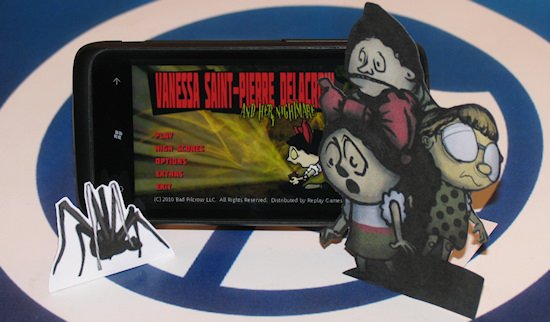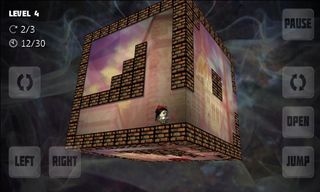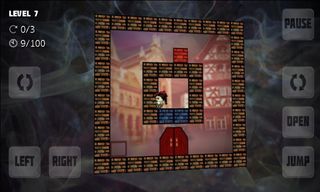Vanessa Saint-Pierre Delacroix and her Nightmare - Review

When I was a wee lad, I thought it would be cool to make a game with the world’s longest title… Something like 20 words long, that would get it noticed! Apparently the folks at indie developer Bad Pilcrow had the same idea, and thus Vanessa Saint-Pierre Delacroix and Her Nightmare was born. The benefit to a giant title like that is that it really does get catch the eye. “That game has seven words in the title! Why, other game titles only have two or three words at most. Could Vanessa Saint-Pierre Delacroix and Her Nightmare be thrice as good as them?” But the problem comes whenever you have to say or type the title and you can’t remember it or your fingers get too tired. Even for this review, I had to copy and paste the title from somewhere else, because my mind isn’t built to remember that mess of proper and common nouns.
Yep, that’s how I chose to establish context. Head past the break for the full review.
Let’s just call it Vanessa

Goofy name aside, Vanessa warrants a look for its unique graphics and gameplay. Vanessa-bo-bessa is a puzzle platformer in which gameplay takes place across each side of a 3D cube. While she can walk left or right and jump, the most important way to get her around obstacles is by rotating the cube left or right. The bottom of the screen is always the source of gravity, so flip the cube upside down and the little girl drops straight down, etcetera.
Levels aren’t confined to only one side of the cube, either; rotating the cube opens and closes paths between the different sides. Tilting the phone offers a peek around those corners. The tilting mechanic needs improvement, as the view can get screwy if you reposition your phone while playing. I hear Bad Pilcrow plans to polish it in the future.
The object of every level is to maneuver Vanessa from the starting point to the exit. While Vanessa looks and plays much differently from ilomilo, they share a similar vibe in that you can often see where you want to go but have to figure out how to navigate the floors, walls, and ceilings to get there. Eventually the designers of the hellish cube world start locking the level exits, which forces Little Miss V to find a key before making her way to the exit door. Some stages also have blocks that must fall onto switches in order to open new pathways. Up to the point I like the mechanics and gameplay.
Good dreams go bad
Get the Windows Central Newsletter
All the latest news, reviews, and guides for Windows and Xbox diehards.

Unlike the stars of ilomilo, Vanessa can actually die. In later levels, abundant spikes threaten to kill the weirdly-named girl if players rotate the cube carelessly. If that wasn’t bad enough, you’re often required to rotate the cube and then steer her as she falls lest she hit some of those spikes. The levels are built around the mechanic, but the touch-screen controls aren’t quite up to snuff. Adding to the pressure on some levels are nasty spiders. They march along predetermined routes (like enemies often did in the 8-bit era whose inspiration is clearly felt) and will end Vanessa’s life if she so much as bumps them.
While I understand the perceived need to include threats and failure conditions in most games, these elements hampered this particular experience for me. Twisting the cube around to help get Vanessa White from point A to B is plenty of fun on its own. But making it far into a level only to fall on some spikes is not. The touch screen controls certainly aren’t up to precision platforming: instead of a nice virtual stick like Sonic 4, Vanessa has ugly and oddly-placed left and right buttons. Their poor placement and responsiveness makes those moments when you have to steer a falling Vanessa away from death rather excruciating. Thankfully the developer has promised to improve them in a future update.
Sure, the game offers unlimited retries, and the low margin for error in later levels means you will likely test some of those limits. With all that said, I did manage to beat all but the last level without searching YouTube for a solution. But if I hadn’t been reviewing Vanessa, I might not have stuck it out till the end.
How Vanessa got her cube back

Vanessa’s story is told via fully voiced introduction and endings. We’re told that Vanessa’s schoolmates relentlessly pick on her because she’s quiet and introspective. Did you ever notice how stories never make the kid who’s picked on seem all that weird? In my experience, you get picked on because you’re genuinely off compared to everybody else, not just quiet. Ah well.
One day ‘Nessa opens a Hellraiser-like puzzle cube in her father’s antique shop, sucking her and her nemeses in. It’s an intriguing setup, featuring a unique and deliberately ‘ugly’ art style. Unfortunately, the narrator Pierre Richard Borges II (His real name or a joke like the title? You be the judge.) is pretty much the worst voice actor I have ever heard outside of the House of the Dead games. When you can’t read a simple paragraph without inserting random inflections, it’s time to put the microphone down and get back to mopping the hallway. So yeah, the intro and outro would be better with text than the current voice, but c'est la vie.
Outside of the bookend sequences, the story fades away except for a few enjoyable levels in which Vanessa must rescue the ungrateful bullies who previously tormented her. I wish the game had more rescue levels and/or intermissions – a stronger carrot-at-the-end-of-a-stick would make the game more compelling. But all in all, what we get here is more than most indie phone games I’ve played.
Graphics and sound

I already touched on the game’s art style a bit, but the visuals deserve more attention. Mapping old-school graphics to a 3D cube looks extremely cool. The backgrounds behind the sprites and cube complement the game’s nightmarish mood.
Less successful is the music. The single tune is just way too boisterous and noisy to carry the whole game. It would be fine for the certain key levels, but not every.single.one. Imagine attending a symphony that plays nothing but the climax the entire time – groan. All good things in moderation, game makers.
Length

Vanessa’s Nightmare lasts for 36 levels, more than justifying the $.99 price. The first few levels go down quickly, but as I mentioned the difficulty ramps up before not too long. The game’s online leaderboards encourage players to try for better completion times and solving levels in less moves. What’s more, the developer offers several downloadable levels to extend the experience.
Overall Impression
Like a well-worn Rubik’s cube, Vanessa Saint-Pierre Delacroix and Her Nightmare is rough around the edges but still offers some side-twisting fun. It’s a callback to the eighties and early nineties when game developers tried all sorts of different things in 2D platformer settings. With better controls and more forgiving level design, I would recommend this game wholeheartedly. Still, if the novel-length name and old-school vibe catch your interest, you need to give it a try.
Vanessa Saint-Pierre Delacroix and Her Nightmare costs $.99 and there is a free trial. Pick the puzzle cube up here at the Marketplace, if you dare.
Paul Acevedo is the Games Editor at Windows Central. A lifelong gamer, he has written about videogames for over 15 years and reviewed over 350 games for our site. Follow him on Twitter @PaulRAcevedo. Don’t hate. Appreciate!
